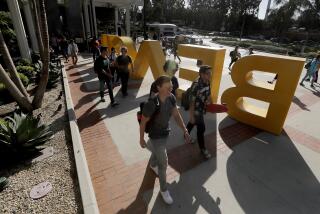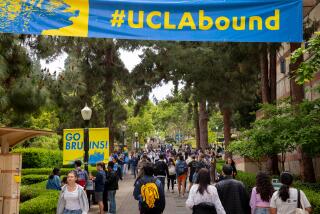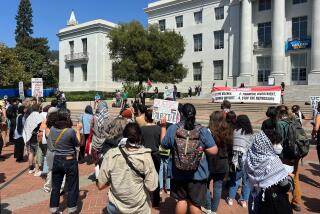Academic Challenge : CSUN Campus Faces Final Quake Repairs, Filling President’s Post
- Share via
NORTHRIDGE — Personnel changes, remediation and the last renovations to buildings damaged during the 1994 Northridge earthquake will top the list of priorities at Cal State Northridge as the campus opens for classes today.
By the end of this academic year, the university will have new leadership, a virtually restored campus and the best opportunity in seven years to focus on issues unrelated to earthquake recovery.
Perhaps the greatest challenge of the next year is to fill dozens of open positions at the university. Four out of five of the university’s executive posts are currently held by interim administrators, including the position of president.
Colleen Bentley-Adler, a spokeswoman for the Cal State Chancellor’s Office, said the presidential search committee will begin sifting through resumes at its next meeting Sept. 24. She estimated that as many as 100 people would apply for the job, which is being publicized in academic journals and by a search firm.
Interim President Louanne Kennedy plans to resume her duties as vice president of academic affairs once a permanent president is selected. The new president will then choose a vice president of student affairs and a vice president of administration and finance.
Cal State Northridge administrators must also fill 80 faculty positions this year. The university failed to meet a hiring goal of the same number last year and 25 positions were rolled over into academic year 1999-2000.
“Things did not go as well as we had hoped,” said John B. Mason, associate vice president for faculty affairs. “If you’re doing 80 searches, you shouldn’t roll over more than 5% of that--there are always a few, but this is too many.”
Mason said Cal State Northridge’s salaries are fairly competitive with comparable schools, but that the high cost of living in Los Angeles may be driving away prospective candidates.
“We’re always dealing with sticker shock,” he said. “In the Valley, which isn’t the highest real estate market in Los Angeles, the median price for a house is [almost] $300,000.”
High course loads may be another obstacle, Mason said. Many Cal State professors teach four classes a week--professors at such research institutions as UCLA often teach one or two classes a week. Administrators say they expect to see the pace of retirements quicken over the next few years as professors hired during academia’s last major expansion in the 1960s reach retirement age.
Hiring “is going to keep us very busy,” Mason said. “It’s high-stress work and intensive activity for our departments. It’s one of the most important things they do and they take it very seriously.”
Even as the university is having a tough time attracting qualified faculty members, the student population grew slightly, continuing a trend that started after the Northridge earthquake. Enrollment was 26,477 Friday morning--up 404 over the same time last year--and will continue to grow until Sept. 17, the registration deadline.
*
Another factor is the new systemwide policy mandating that freshmen who fail competency exams complete remedial math or English courses during their first academic year.
Of 2,000 freshmen in 1998, about 173 failed to meet remedial requirements and flunked out. Still hanging in the balance is the fate of about 200 students who must complete remediation this semester or leave Cal State Northridge, said Robert Danes, the university’s director of undergraduate students.
“I think the number of students who [dropped] out is a much better number than we feared it might be,” Danes said. “We were hoping it would be a smaller number, naturally, but we were expecting it might be much higher than that.”
The number of current freshmen in need of remedial courses will be released this week, Danes said, adding that students seemed better prepared this year.
University officials also hope to finish $40 million in renovation projects that will erase the last physical reminders of the 1994 earthquake on campus. Facilities Planning Director Tom Tindall said repairs to the Student Services Building, Sierra Hall and the Oviatt Library wings will be finished by spring. Construction on a series of new buildings--the arts media and communication building, the health and human development and technology building and the new administration building--will be completed in 2001. Seven years after the Northridge quake, those projects will cap the Federal Emergency Management Agency’s $410-million effort to restore the campus.
Students are trying to end a longtime controversy over a proposed football stadium that has been vehemently opposed by some homeowners, who say it would generate too much noise and erode property values.
Former President Blenda Wilson approved the proposed 8,500-seat stadium, in principle, before she left in June.
A proposal to raise more than $80 million for a new recreation center, football stadium and baseball stadium by increasing student fees will be the subject of a referendum Oct. 12 and 13. Initially, students would be charged $27 a semester to fund the plan; after construction is finished, students would pay $90 a semester.
“The students who actually see the facilities would actually pay the bulk of the money,” said Robert Hanf, president of the student body. The recreation center would include basketball courts, exercise rooms, an indoor track, a swimming pool and racquetball courts. The baseball stadium would seat as many as 3,000 spectators, Hanf said.
In March, students at the university’s Ventura campus helped defeat a measure that asked for a $75 fee increase over three years to finance the recreation center. About 20% of the Ventura student body, or about 387 students, voted, but only 5%, or 1,262 students, voted at Northridge. Hanf said funds from Northridge’s Ventura satellite campus would revert to that campus.
One of the most ambitious development projects at Cal State Northridge is already well underway. Construction has begun on the first phase of a North Campus biotechnology complex--a private-public partnership scheduled for completion by the end of next year and expected to generate at least $800,000 in lease payments.
The complex would house Alfred Mann’s MiniMed facility, which produces insulin pumps and other biotech devices. The first phase of the construction will use 19 acres of the 65-acre plot. Mann will lease an additional nine acres once the old stadium is demolished, McCarron said. Mann has also expressed interest in an additional 12 acres because of how rapidly his company is expanding.
University Corporation Director Thomas McCarron said he would try to find another occupant for the rest of the North Campus land.
“In the Valley it’s getting harder and harder to find large parcels,” said McCarron. “You can find two to four acres, but you cannot find 10 acres.”
*
In a statement issued last week, Kennedy said she was optimistic about the coming year and confident that her team of interim administrators could meet the challenges ahead of them.
“Institutions such as Cal State Northridge are stronger than any particular set of individuals.”
More to Read
Sign up for Essential California
The most important California stories and recommendations in your inbox every morning.
You may occasionally receive promotional content from the Los Angeles Times.










